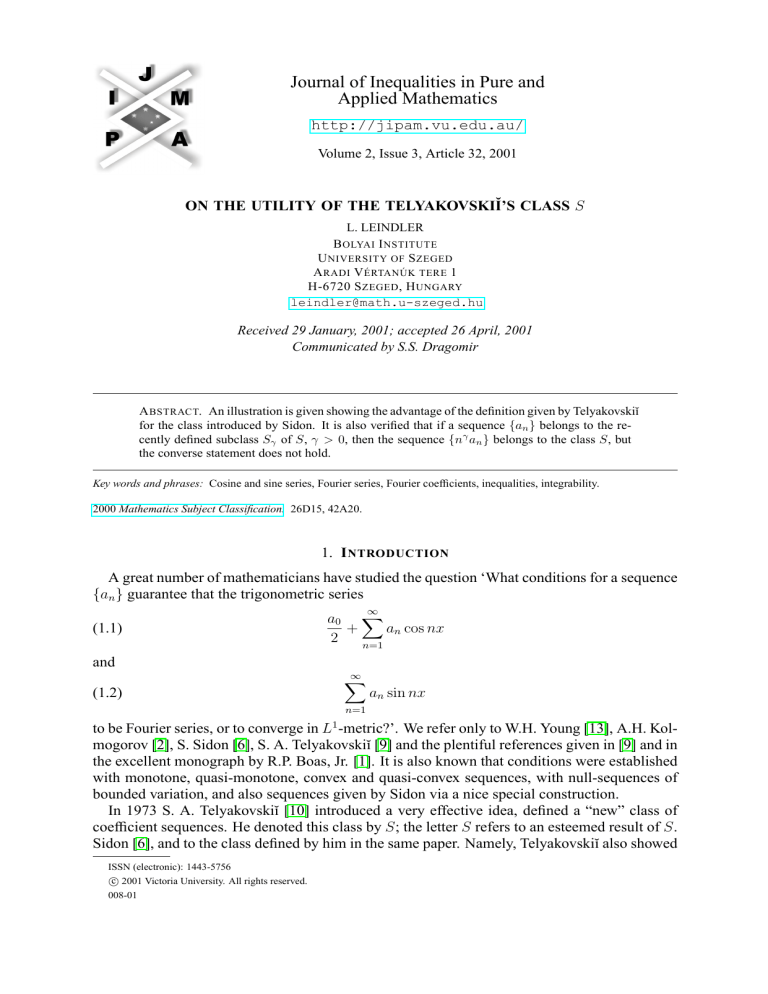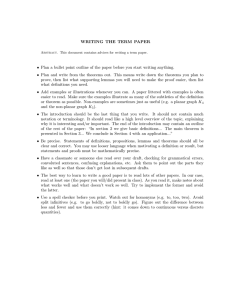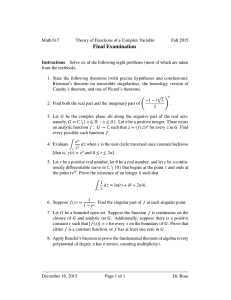
Journal of Inequalities in Pure and
Applied Mathematics
http://jipam.vu.edu.au/
Volume 2, Issue 3, Article 32, 2001
ON THE UTILITY OF THE TELYAKOVSKIĬ’S CLASS S
L. LEINDLER
B OLYAI I NSTITUTE
U NIVERSITY OF S ZEGED
A RADI V ÉRTANÚK TERE 1
H-6720 S ZEGED , H UNGARY
leindler@math.u-szeged.hu
Received 29 January, 2001; accepted 26 April, 2001
Communicated by S.S. Dragomir
A BSTRACT. An illustration is given showing the advantage of the definition given by Telyakovskiı̆
for the class introduced by Sidon. It is also verified that if a sequence {an } belongs to the recently defined subclass Sγ of S, γ > 0, then the sequence {nγ an } belongs to the class S, but
the converse statement does not hold.
Key words and phrases: Cosine and sine series, Fourier series, Fourier coefficients, inequalities, integrability.
2000 Mathematics Subject Classification. 26D15, 42A20.
1. I NTRODUCTION
A great number of mathematicians have studied the question ‘What conditions for a sequence
{an } guarantee that the trigonometric series
∞
a0 X
(1.1)
+
an cos nx
2
n=1
and
∞
X
(1.2)
an sin nx
n=1
1
to be Fourier series, or to converge in L -metric?’. We refer only to W.H. Young [13], A.H. Kolmogorov [2], S. Sidon [6], S. A. Telyakovskiı̆ [9] and the plentiful references given in [9] and in
the excellent monograph by R.P. Boas, Jr. [1]. It is also known that conditions were established
with monotone, quasi-monotone, convex and quasi-convex sequences, with null-sequences of
bounded variation, and also sequences given by Sidon via a nice special construction.
In 1973 S. A. Telyakovskiı̆ [10] introduced a very effective idea, defined a “new” class of
coefficient sequences. He denoted this class by S; the letter S refers to an esteemed result of S.
Sidon [6], and to the class defined by him in the same paper. Namely, Telyakovskiı̆ also showed
ISSN (electronic): 1443-5756
c 2001 Victoria University. All rights reserved.
008-01
2
L. L EINDLER
that his class and that of Sidon are identical, but to apply his definition is more convenient. This
is the reason, in my view, that later most of the authors ([7], [8], [14]), dealing with similar
problems, wanted to extend the definition of Telyakovskiı̆.
In [3] and [4] we showed that some of these “extensions” are equivalent to the class S, and
some others are real extensions of S, but they are identical among themselves.
All of these facts show that the class S defined by Telyakovskiı̆ plays a very important role
in the studies of the problems mentioned above.
The definition of the class S is the following: A null-sequence a := {an } belongs to the
class
P∞ S, or briefly a ∈ S, if there exists a monotonically decreasing sequence {An } such that
n=1 An < ∞ and |∆an | ≤ An hold for all n.
The aim of the present note is to give one further illustration which underlies the central
position of the class S and the following theorems proved in the same paper where the definition
of S was given.
In [10] Telyakovskiı̆, among others, proved the next two theorems.
Theorem 1.1. Let the coefficients of the series (1.1) belong to the class S. Then the series (1.1)
is a Fourier series and
Z π
∞
∞
X
a0 X
+
an cos nx dx ≤ C
An ,
2
0
n=1
n=0
where C is an absolute constant.
Theorem 1.2. Let the coefficients of the series (1.2) belong to the class S. Then for any p =
1, 2, . . .
!
Z π X
p
∞
∞
X
X
|an |
+O
An
an sin nx dx =
π
n
n=1
n=1
p+1 n=1
holds uniformly.
In particular, the series (1.2) is a Fourier series if and only if
∞
X
|an |
n=1
n
< ∞.
Recently Z. Tomovski [12] defined certain subclasses of S, and denoted them by Sr , r =
1, 2, . . . (see also [11] and in [5] the definition of the class S(α)). A null-sequence {an } be(r)
longs to the class Sr , if there exists a monotonically decreasing sequence {An } such that
P∞
(r)
(0)
r (r)
n=1 n An < ∞ and |∆an | ≤ An for all n. (For r = 0 clearly S0 = S and An = An .)
In [11] Tomovski established, among others, two theorems in connection with the classes Sr
as follows:
Theorem 1.3. Let the coefficients of the series (1.1) belong to the class Sr , r = 0, 1, . . .. Then
the r-th derivative of the series (1.1) is a Fourier series and if f (r) (x) denotes its sum function
we have that
Z π
∞
X
(r)
f (x) dx ≤ M
nr A(r)
M = M (r) > 0.
n ,
0
n=0
Theorem 1.4. Let the coefficients of the series (1.2) belong to the class Sr , r = 0, 1, . . ., furthermore let g(x) denote the sum function of the series (1.2). Then for any p = 1, 2, . . .
!
Z π
p
∞
X
X
|g (r) (x)|dx =
|an |nr−1 + O
nr A(r)
.
n
π
p+1
J. Inequal. Pure and Appl. Math., 2(3) Art. 32, 2001
n=1
n=1
http://jipam.vu.edu.au/
O N THE U TILITY OF THE T ELYAKOVSKI Ĭ ’ S C LASS S
3
In particular, the r-th derivative of the series (1.2) is a Fourier series if and only if
∞
X
|an |nr−1 < ∞.
n=1
It is obvious that if r = 0 then the Theorems 1.3 and 1.4 reduce to the Theorems 1.1 and 1.2,
respectively.
The proof of Theorem 1.3 has not yet appeared, the proof of Theorem 1.4 given in [11] is a
constrictive one, follows similar lines as that of Telyakovskiı̆.
Now, we shall verify that if a sequence {an } belongs to Sr , then the sequence {nr an } belongs
to S, with such a sequence {An } which satisfies the inequality
∞
X
(1.3)
An ≤ (r + 1)
n=1
∞
X
nr A(r)
n ,
(An ≡ A(0)
n ).
n=1
Thus, this result and the Theorems 1.1 and 1.2 immediately imply the Theorems 1.3 and 1.4,
respectively.
2. R ESULTS
We shall deduce our assertion from a somewhat more general result. In the Introduction we
have already referred to that in [5], we also defined a certain subclass of S as follows:
Let α := {αn } be a positive monotone sequence tending to infinity. A null-sequence {an }
(α)
belongs to the class S(α), if there exists a monotonically decreasing sequence {An } such that
∞
X
αn A(α)
n < ∞,
and |∆an | ≤ A(α)
n
for all n.
n=1
If we denote the class S(α), where αn := nα , α > 0, by Sα , that is, if we introduce the
definition Sα := S(nα ), we immediately get the generalization of the classes Sr , r = 1, 2, . . . ,
for any positive α.
We shall prove our result for the classes Sα , α > 0.
Theorem 2.1. Let γ ≥ β > 0. If {an } belongs to the class Sγ , then the sequence {nβ an }
belongs to the class Sγ−β and
(2.1)
∞
X
n
γ−β
A(γ−β)
n
≤ (β + 1)
n=1
∞
X
nγ A(γ)
n
n=1
holds.
It is clear that if γ = β = r then (2.1) gives (1.3). Thus the inequality (1.3), utilizing the
assumptions of Theorem 1.3 and 1.4, and the statements of Theorems 1.1 and 1.2, implies the
assertions of Theorems 1.3 and 1.4, respectively.
This is a new and short proof for the Theorems 1.3 and 1.4.
Remark 2.2. The statement of the theorem is not reversible in general.
3. P ROOFS
Proof of Theorem 2.1. In ordernto proveoour theorem we have to verify that there exists a mono(γ−β)
tonically decreasing sequence An
such that (2.1) and
(3.1)
J. Inequal. Pure and Appl. Math., 2(3) Art. 32, 2001
|∆(nβ an )| ≤ A(γ−β)
n
http://jipam.vu.edu.au/
4
L. L EINDLER
hold. Since {an } ∈ Sγ thus if β ≥ 1 then
|∆(nβ an )| = |nβ (an − an+1 ) − an+1 ((n + 1)β − nβ )|
(3.2)
≤ nβ |∆an | + β(n + 1)β−1 |an+1 |
∞
X
(γ)
β (γ)
(β−1)
≤ n An + β(n + 1)
Ak .
k=n+1
Now define
A(γ−β)
n
:= n
β
A(γ)
n
∞
X
+β
(γ)
k β−1 Ak .
k=n+1
(γ−β)
By this definition and (3.2) it is clear that (3.1) holds. Next we show that the sequence {An
is monotonic, that is
(γ−β)
.
An+1 ≤ A(γ−β)
n
(γ)
}
(γ)
Since (n + 1)β ≤ nβ + β(n + 1)β−1 and An+1 ≤ An , thus
(γ−β)
An+1
= (n + 1)
β
(γ)
An+1
∞
X
+β
(γ)
k β−1 Ak
k=n+2
≤ n
β
A(γ)
n
+ β(n + 1)
β−1
(γ)
An+1
∞
X
+β
(γ)
k β−1 Ak = A(γ−β)
.
n
k=n+2
Finally we verify (2.1). Since
∞
X
nγ−β A(γ−β)
=
n
n=1
≤
∞
X
nγ A(γ)
n +β
∞
X
n=1
n=1
∞
X
∞
X
n
γ
A(γ)
n
+β
n=1
nγ−β
∞
X
k=n+1
k
β−1
(γ)
Ak
≤ (β + 1)
k
X
nγ−β
n=1
k=2
∞
X
(γ)
k β−1 Ak
nγ A(γ)
n .
n=1
If 0 < β < 1 then, using the first equality of (3.2), we get that
β
|∆(n an )| ≤ n
β
A(γ)
n
+ βn
β−1
∞
X
(γ)
Ak .
k=n+1
Henceforth the proof follows the lines given for β ≥ 1 if we define
A(γ−β)
n
:= n
β
A(γ)
n
+ βn
β−1
∞
X
(γ)
Ak .
k=n+1
Herewith the proof is complete.
Proof of Remark 2.2. It suffices to prove the remark for the case γ = β = 1. We know that if
{an } ∈ S1 then {nan } ∈ S. Our next example will show that there exists a sequence {cn } such
that {ncn } ∈ S but {cn } ∈
/ S1 . This verifies that the implication
{an } ∈ S1 ⇒ {nan } ∈ S
is not reversible.
J. Inequal. Pure and Appl. Math., 2(3) Art. 32, 2001
http://jipam.vu.edu.au/
O N THE U TILITY OF THE T ELYAKOVSKI Ĭ ’ S C LASS S
5
Put
1
, n ≥ 1.
n log(n + 1)
Then the sequence {ncn } is monotonically decreasing, tends to zero, and thus clearly belongs
to the class S.
On the other hand
1
|∆cn | ≥
,
n(n + 1) log(n + 1)
whence
∞
X
nA(1)
n = ∞
cn :=
n=1
(1)
An
obviously follows if
≥ |∆cn | holds, consequently {cn } does not belong to S1 .
This proves Remark 2.2.
R EFERENCES
[1] R. P. BOAS JR., Integrability theorems for trigonometric transforms, Springer-Verlag, Ergebnisse
38, Berlin, 1967.
[2] A. N. KOLMOGOROV, Sur l’ordre de grandeur des coefficients de la série de Fourier-Lebesgue,
Bull. Acad. Polon. Sci. (A), Sci. Math., (1923), 83–86.
[3] L. LEINDLER, On the equivalence of classes of Fourier coefficients, Math. Ineq. & Appl., 3 (2000),
45–50.
[4] L. LEINDLER, On the equivalence of classes of numerical sequences, Analysis Math., 26 (2000),
227–234.
[5] L. LEINDLER, Classes of numerical sequences, Math. Ineq & Appl., 4(4) (2001), 515–526.
[6] S. SIDON, Hinreichende Bedingungen für den Fourier-charakter einer trigonomet-rischen Reihe, J.
London Math. Soc., 14 (1939), 158–160.
[7] N. SING AND K. M. SHARMA, Integrability of trigonometric series, J. Indian Math. Soc., 49
(1985), 31–38.
[8] Č. V. STANEJEVIČ, and V.B. STANOJEVIČ, Generalizations of Sidon-Telyakovskiı̆, theorem,
Proc. Amer. Math. Soc., 101 (1987), 679–684.
[9] S. A. TELYAKOVKSKIĬ, Conditions for integrability of trigonometric series and their application to
study linear summability methods of Fourier series, Izvestiya Akad. Nauk SSSR, (Russian) 28 (1964),
1209–1236.
[10] S. A. TELYAKOVSKIĬ, On a sufficient condition of Sidon for integrability of trigonometric series,
Math. Zametki, (Russian) 14 (1973), 317–328.
[11] Ž. TOMOVSKI, Some results on L1 -approximation of the r-th derivative of Fourier series, accepted for publication in J. Inequal.Pure and Appl. Math. and will appear in volume 3, issue 1,
2002. A pre-print is available on-line at RGMIA Research Report Collection, 2(5), Article 11, 1999;
http://rgmia.vu.edu.au/v2n5.html
[12] Ž TOMOVSKI, An extension of the Sidon-Fomin inequality and applications, Math. Ineq & Appl.,
4(2) (2001), 231–238.
[13] W. H. YOUNG, On the Fourier series of bounded functions, Proc. London Math. Soc., 12 (1913),
41–70.
[14] S. Z. A. ZENEI, Integrability of trigonometric series, Tamkang J. Math., 21 (1990), 295–301.
J. Inequal. Pure and Appl. Math., 2(3) Art. 32, 2001
http://jipam.vu.edu.au/






